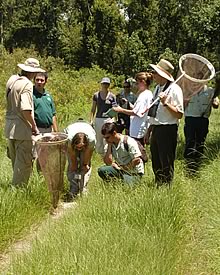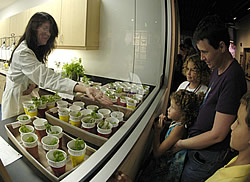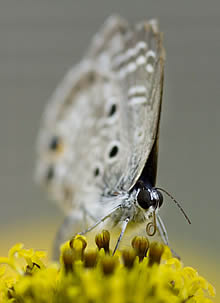Just as a butterfly leaves the chrysalis to spread its wings, in May 2007 the Butterfly Conservation Initiative decided to make a move that would allow the organization to take flight.

Armed with resources that would allow the program to expand, Stephanie Sanchez was named program coordinator when the Butterfly Conservation Initiative headquarters moved from the Association of Zoos and Aquariums in Baltimore to one of the initiative’s founding member organizations, the McGuire Center for Lepidoptera and Biodiversity at the Florida Museum of Natural History.
The Butterfly Conservation Initiative — a coalition of member zoos, aquariums, botanical gardens, museums and seven partner organizations — was created in 2001 to work with federal and state organizations to aid in the conservation of threatened, endangered and vulnerable North American butterflies and the habitats that sustain them.

Photo by Jaret Daniels
In its first year at the McGuire Center, the Butterfly Conservation Initiative has grown into its new home and expanded by adding two new member organizations. The Florida Aquarium in Tampa and the Bronx Zoo have joined the 41 other organizations as part of the initiative and several other organizations are beginning the membership process, Sanchez said. The initiative also attracted national attention as the first organization chosen by “News of the Lepidopterists’ Society” for a series on conservation issues.
Since taking over as program director, Sanchez has had the opportunity to oversee the start of several new cooperative projects. The Cheyenne Mountain Zoo and U.S. Fish and Wildlife Service joined forces in a conservation effort to save endangered butterflies in Colorado. According to Sanchez, the Cheyenne Mountain project has the potential to be successful and reach people in a part of the country where the Butterfly Conservation Initiative hasn’t had much activity.
“Many of the partnerships created through the initiative result in projects like these and provide opportunities for organizations to expand their conservation efforts,” Sanchez said. “Member projects range in scope from exhibits and public education efforts to full-scale habitat restoration, species captive propagation and organism reintroduction. Some of our members are leaders in conservation, while others are taking their first steps.”
While the initiative was headquartered in Baltimore, Sanchez’s predecessors Ruth Allard and Shelly Grow created a solid base of information for Sanchez to work from.
“A lot of great work was done before the initiative moved to the McGuire Center,” Sanchez said. “Then came the question of ‘Where do I begin and where do I go?'”
Sanchez adapted to the organization’s work quickly and began moving forward, writing grants, editing the newsletter and most importantly creating new partnerships in conservation.

Photo by Jeff Gage
The program has made itself at home at the McGuire Center, taking advantage of the world-class research facilities and giving Florida Museum visitors an opportunity to see conservation efforts first-hand.
“When working with small invertebrates, like butterflies, it’s easy to show someone what species conservation means,” Sanchez said.
One example is the McGuire Center’s Special Projects Lab, home to several butterfly conservation projects, including that of the Miami blue. The small space requirement for butterfly conservation projects also makes it easy for organizations of all sizes to participate. It brings conservation into visitors’ backyard, she added.
In addition to habitat recovery and species research, the program actively provides conservation education resources to individuals and organizations, allowing members with different backgrounds the opportunity to share their experiences with one another. The initiative created one of the first professional courses in butterfly conservation, where people and organizations wishing to begin a conservation project can learn what is necessary from experienced initiative members and the staff at the McGuire Center. This cross-training system strengthens not only each individual organization’s project, but the future of butterfly conservation.
“The backbone of conservation success is the development of synergistic partnerships,” said Jaret Daniels, initiative steering committee member and McGuire Center assistant director for research.

Photo by Eric Zamora
Daniels has worked with the program since 2003 and seen what he calls an “impressive” number and scope of butterfly-related projects developed.
“The interest in butterflies and their conservation continues to grow tremendously on a nationwide level as does the number of professionals dedicated to research, education and recovery,” he said.
Through these and other projects, Sanchez and fellow initiative members from around the country have been spreading the word about butterfly conservation. At the 2008 national Association of Zoos and Aquariums conference Sept. 15 -18, Sanchez and several other active members of the Butterfly Conservation Initiative will host a session discussing alliances between the Association of Zoos and Aquariums and U.S. Fish and Wildlife Service.
“I hope the session will inspire other institutions to reach out and form new partnerships for conservation, as a variety of partners can always have a greater impact than any one of us could have alone,” Sanchez said.
“It is a genuine pleasure to be a part of the Butterfly Conservation Initiative community,” she said. “It’s a job where you really feel good about what you’ve done at the end of the day. I think everyone [who works] in conservation must feel that way.”